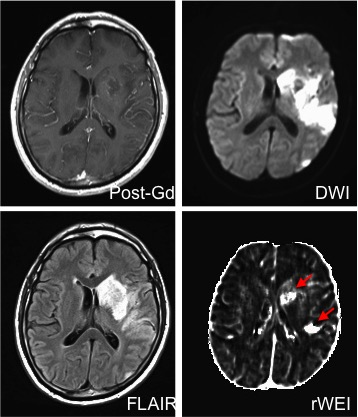4352
Mapping of Relative Water Exchange Index (rWEI) in Post Thrombectomy Patients1Radiology, MGH, Charlestown, MA, United States, 2Neuroradiology, Brown University, Providence, RI, United States
Synopsis
Previously, water exchange index (WEI) was proposed to quantify the rate of water movement across the blood-brain barrier (BBB). Although efficient and clinically applicable, the technique could not reliably provide voxelwise WEI maps due to the inadequate signal to noise ratio (SNR). In remedy of this shortcoming, we here present the relative WEI (rWEI) method, which enables voxelwise mapping of BBB water exchange while significantly reducing the acquisition time (< 10 min). To confirm the validity of the technique, the rWEI maps were acquired in post thrombectomy patients with unilateral infarct and compared with the WEI values.
Synopsis
Previously, water exchange index (WEI) was proposed to quantify the rate of water movement across the blood-brain barrier (BBB). Although efficient and clinically applicable, the technique could not reliably provide voxelwise WEI maps due to the inadequate signal to noise ratio (SNR). In remedy of this shortcoming, we here present the relative WEI (rWEI) method, which enables voxelwise mapping of BBB water exchange while significantly reducing the acquisition time (< 10 min). To confirm the validity of the technique, the rWEI maps were acquired in post thrombectomy patients with unilateral infarct and compared with the WEI values.Introduction
Fractional cerebral blood volume (CBV) can be estimated using the steady state MRI signals before and after T1 contrast agent occupies the vascular space.(1) The accuracy of such CBV measurements is typically dependent on the movements of water molecules across BBB, in which the degree of measurement errors also depends on the selection of MRI parameters.(2) In particular, based on the dependence of such deviation of CBV estimates on flip angle, water exchange index (i.e., WEI) was proposed, which is linearly proportional to the BBB water exchange rate.(2) Despite the practical utility with the procedure time under 20 min and not requiring any complicated modeling, the technique could not reliably produce voxel-wise maps of WEI due to the low signal to noise ratio (SNR). For this purpose, we propose to modify WEI by replacing the absolute CBV required for WEI calculation with the relative CBV (rCBV) which can be obtained via dynamic susceptibility contrast (DSC) imaging procedure during the Gd-DTPA injection. The concept of relative WEI (rWEI) also reduces the MRI acquisition time compared to the previous WEI technique nearly by half, thus making the measurement of BBB water exchange much more applicable for patients who are subjected to contrast agent administration.Methods
Post thrombectomy patients (N=4) were imaged in a 3T clinical scanner (Trio; Siemens) before and after Gd-DTPA injection using flow-compensated 3D multi gradient echo with TR=40 ms, 8 echoes at TE=[2.65, 4.06, 5.51, 6.94, 8.37, 9.80, 11.23, 12.66 ms], matrix=256x256, FOV=266 mm, 48 slices, slice thickness=4 mm and flip angles at 30 and 80. For acquiring rCBV, DSC was performed using the standard injection protocol and EPI with TR=1800 ms, TE=40 ms and 80 time points. ROI’s were selected over the infarct (defined by ADC: 25% lower than contralesional counter part) and non-infarct areas. All imaging processing was performed using AFNI.Results
None of patients displayed extravasation of Gd-DTPA as shown in the T1 weighted post contrast images (Fig 1). The water exchange index (WEI: which is largely proportional to the actual water exchange rate) and rWEI were successfully quantified and compared against each other. Both WEI and rWEI were similarly stable in the non-infarct regions (see Fig 2) but significantly elevated in the infarct areas compared to homologous counterparts in the contralateral hemisphere, confirming the validity of rWEI as a measure of the abnormal BBB water exchange rate. However, % increase of the BBB water exchange in the stroke region was significantly higher for rWEI than WEI (see Fig 2), possibly due to a nonlinear relationship between CBV and rCBV. In addition, voxelwise rWEI maps revealed hyper-intense water exchange regions within the stroke area, which do not correlate with any maps obtained by other traditional MRI methods including DWI and FLAIR (Fig 1).Discussion
The purpose of current investigation was to devise a practical strategy to provide a parameter that efficiently represents the BBB water exchange rate under clinical setting. By utilizing rCBV derived from the typical DSC imaging during Gd-DTPA administration, the voxelwise whole brain map of rWEI could be acquired in less than 10 min. Although a proper standardization is probably required for comparison across patients, the rWEI method is highly user-friendly and able to provide the BBB water exchange map without the requirement of complicated modeling, novel pulse sequences or optimization process. In particular, rWEI maps were used to successfully isolate brain areas of the weakened barrier function of BBB where no extravasation of contrast agent is observed. Along with curtailed scan time, the rWEI method can be an efficient way to quantify subtle changes in local BBB dysfunction as well as used as a predictive guideline for clinical procedures that require functional status of the BBB.(3)Conclusion
An efficient, clinical strategy to map the water exchange in the whole brain under 10 min (Relative Water Exchange Index: rWEI) is introduced for identifying regions pertaining to subtle impairment in the barrier function of BBB.Acknowledgements
No acknowledgement found.References
(1) Kim YR, Tejima E, Huang S, Atochin DN, Dai G, Lo EH, Huang PL, Bogdanov A, Jr., Rosen BR. In vivo quantification of transvascular water exchange during the acute phase of permanent stroke. Magn Reson Med. 2008;60(4):813-21.
(2) Huang S. Dynamic Monitoring of Blood-Brain Barrier Integrity using Water Exchange Index (WEI) During Mannitol and CO2 Challenges in Mouse Brain. NMR in Biomedicince. 2013 April;26(4) 376-385.
(3) Huang S. Cerebral blood volume affects blood-brain barrier integrity in an acute transient stroke model. J Cereb Blood Flow Metab. 2013 Jun;33(6):898-905
Figures

